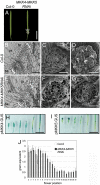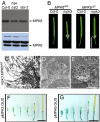Regulation of floral organ abscission in Arabidopsis thaliana
- PMID: 18809915
- PMCID: PMC2563077
- DOI: 10.1073/pnas.0805539105
Regulation of floral organ abscission in Arabidopsis thaliana
Abstract
Abscission is a developmental program that results in the active shedding of infected or nonfunctional organs from a plant body. Here, we establish a signaling pathway that controls abscission in Arabidopsis thaliana from ligand, to receptors, to downstream effectors. Loss of function mutations in Inflorescence Deficient in Abscission (IDA), which encodes a predicted secreted small protein, the receptor-like protein kinases HAESA (HAE) and HAESA-like 2 (HSL2), the Mitogen-Activated Protein Kinase Kinase 4 (MKK4) and MKK5, and a dominant-negative form of Mitogen-Activated Protein Kinase 6 (MPK6) in a mpk3 mutant background all have abscission-defective phenotypes. Conversely, expression of constitutively active MKKs rescues the abscission-defective phenotype of hae hsl2 and ida plants. Additionally, in hae hsl2 and ida plants, MAP kinase activity is reduced in the receptacle, the part of the stem that holds the floral organs. Plants overexpressing IDA in a hae hsl2 background have abscission defects, indicating HAE and HSL2 are epistatic to IDA. Taken together, these results suggest that the sequential action of IDA, HAE and HSL2, and a MAP kinase cascade regulates the programmed separation of cells in the abscission zone.
Conflict of interest statement
The authors declare no conflict of interest.
Figures





Similar articles
-
NEVERSHED and INFLORESCENCE DEFICIENT IN ABSCISSION are differentially required for cell expansion and cell separation during floral organ abscission in Arabidopsis thaliana.J Exp Bot. 2013 Dec;64(17):5345-57. doi: 10.1093/jxb/ert232. Epub 2013 Aug 20. J Exp Bot. 2013. PMID: 23963677
-
Ligand-Induced Receptor-like Kinase Complex Regulates Floral Organ Abscission in Arabidopsis.Cell Rep. 2016 Feb 16;14(6):1330-1338. doi: 10.1016/j.celrep.2016.01.023. Epub 2016 Feb 4. Cell Rep. 2016. PMID: 26854226 Free PMC article.
-
The EPIP peptide of INFLORESCENCE DEFICIENT IN ABSCISSION is sufficient to induce abscission in arabidopsis through the receptor-like kinases HAESA and HAESA-LIKE2.Plant Cell. 2008 Jul;20(7):1805-17. doi: 10.1105/tpc.108.059139. Epub 2008 Jul 25. Plant Cell. 2008. PMID: 18660431 Free PMC article.
-
IDA: a peptide ligand regulating cell separation processes in Arabidopsis.J Exp Bot. 2013 Dec;64(17):5253-61. doi: 10.1093/jxb/ert338. Epub 2013 Oct 22. J Exp Bot. 2013. PMID: 24151306 Review.
-
Re-evaluation of the ethylene-dependent and -independent pathways in the regulation of floral and organ abscission.J Exp Bot. 2019 Mar 11;70(5):1461-1467. doi: 10.1093/jxb/erz038. J Exp Bot. 2019. PMID: 30726930 Review.
Cited by
-
IDA (INFLORESCENCE DEFICIENT IN ABSCISSION)-like peptides and HAE (HAESA)-like receptors regulate corolla abscission in Nicotiana benthamiana flowers.BMC Plant Biol. 2021 May 21;21(1):226. doi: 10.1186/s12870-021-02994-8. BMC Plant Biol. 2021. PMID: 34020584 Free PMC article.
-
Polyamine-induced modulation of genes involved in ethylene biosynthesis and signalling pathways and nitric oxide production during olive mature fruit abscission.J Exp Bot. 2011 Aug;62(13):4447-65. doi: 10.1093/jxb/err124. Epub 2011 Jun 1. J Exp Bot. 2011. PMID: 21633085 Free PMC article.
-
Two phylogenetically unrelated peptide-receptor modules jointly regulate lateral root initiation via a partially shared signaling pathway in Arabidopsis thaliana.New Phytol. 2022 Feb;233(4):1780-1796. doi: 10.1111/nph.17919. Epub 2022 Jan 3. New Phytol. 2022. PMID: 34913488 Free PMC article.
-
MAP kinase cascades in plant development and immune signaling.EMBO Rep. 2022 Feb 3;23(2):e53817. doi: 10.15252/embr.202153817. Epub 2022 Jan 18. EMBO Rep. 2022. PMID: 35041234 Free PMC article. Review.
-
Involvement of potato (Solanum tuberosum L.) MKK6 in response to potato virus Y.PLoS One. 2014 Aug 11;9(8):e104553. doi: 10.1371/journal.pone.0104553. eCollection 2014. PLoS One. 2014. PMID: 25111695 Free PMC article.
References
Publication types
MeSH terms
Substances
LinkOut - more resources
Full Text Sources
Other Literature Sources
Molecular Biology Databases
Miscellaneous

